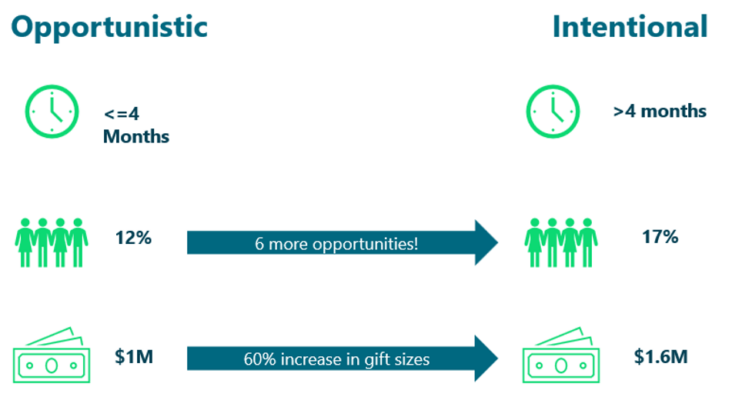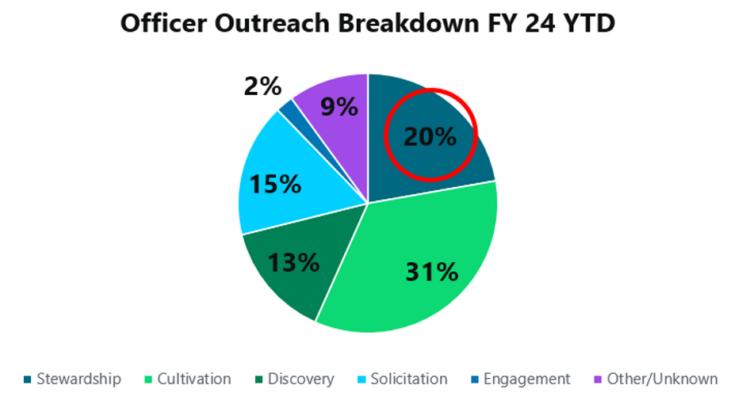Let it Go: When to Move on from a Major Gift Prospect

Seven contact attempts over six months, via at least two contact methods.
This marks the end of the qualification road for one nonprofit organization.
While this scenario represents a best practice for major donor portfolios, there is no one answer to the question of when to disqualify a prospect. The important point is to have a roadmap and a system in place for navigating it.
There are three major exits you can take on the “Highway of Major Gift Giving.”
- Exit 1: Disqualification Road
- Exit 2: Proposal Avenue
- Exit 3: The Stewardship Fork
Once you know what road you’re on with a potential donor, you can decide to press the gas or to let it go and move on to a better-fit major gift prospect.
5 Key Qualification Questions
Before we take a drive down Disqualification Road, let’s identify what it means for a prospect to be truly qualified.
- In general, do they have a philanthropic disposition?
- Are they inclined to be philanthropic to our organization?
- Do I have an estimate of how much they can give?
- Do I have a sense of where they would like to direct their support?
- How long will it take to make the ask?
All positive answers? Then the prospect should move on to cultivation. You will create a proposaloropportunity and plan out the solicitation of that prospect.
At least one negative answer? Then the prospect is disqualified and should be removed from the prospect portfolio and/or reclassified.
Answers unknown? Then you must do further qualification to determine where to go next.
Exit 1: Disqualification Road, Where Prospect Churn Lives
The goal of qualification is to turn your big pool of suspects into a curated list of major gift prospects. When done correctly and at scale, qualification can generate many important data points about your prospect. That’s data you need to capture and analyze.
By creating specific, concrete rules and processes for moving prospects in and out of portfolios, you can ensure that the good work being done by your team is accurately captured and leveraged. It takes discipline to follow a disqualification rubric. But it will ensure that each prospect ends up in the proper place, as disqualification keeps portfolios dynamic, productive, and hygienic.
On-demand video: Roadmap for the Front Line: Major Gift Fundraising Best Practices
The disqualification move offers many benefits, such as improving fundraiser productivity and accelerating the speed to close on major gifts. It is an essential part of the post-qualification cycle for major gift officers (MGOs).
“While we hope to convert every prospect into a major gift donor, the reality is that’s not possible,” said Chris Day, Principal Strategic Consultant at Blackbaud. “Encouraging officers to work towards disqualification as a viable outcome is an important strategy—in other words, churn in prospect portfolios is necessary.”
Churn at the organizational level is critical to ensure that gift officers are efficiently uncovering best-fit prospects. Research from Blackbaud Fundraiser Performance Management™ identified a significant data point in favor of churn:
- About 66% of high value prospects—defined as prospects with $1 million or more in net worth and scoring in the top 5% of constituents for major gift capacity and affinity—are unassigned to gift officers.
That’s a vast pool of untapped opportunity. When you make disqualification a frequent exit on your fundraising journey, the resulting churn will help you make space for future potentially qualified prospects.
But, What Kind of Disqualification?
Not all “no’s” are equal, which is why your organization should develop a plan to filter lists, creating a more nuanced view for revisiting prospects in the future.
There are three primary forms of disqualification.
- Permanent disqualification: a prospect who has said unequivocally “not interested” and will never be interested in supporting the organization.
- Action: Let it go.
- Disqualified, bad timing: a prospect who is inclined to make a major gift at some point in the future, but the time required to secure a gift is beyond a reasonable/viable expectation for an officer to remain assigned (usually three years or more).
- Action: Let it go for now. Prospects should be reclassified and revisited at a determined point in time. In the interim, consider moving these prospects into leadership annual giving and/or alumni relations workflows to keep the relationships warm.
- Disqualified, unresponsive: a prospect who could potentially be viable, but after a reasonable number of attempts (e.g., 5-7 attempts), an officer has been unable to make meaningful contact with them.
- Action: Let it go to another team for now. Prospects should be disqualified but referred to prospect research/biographical records to attempt to refresh contact information before being reassigned to officer portfolios.
Exit 2: Proposal Avenue, Where You Go to Avoid Bottlenecks
If a prospect bypasses the Disqualification Exit, the next opportunity for them to leave the portfolio is in the cultivation stage because that’s where bottlenecks present you with an opportunity.
On average, this is what happens in cultivation:
- 725 days is the length of time an assigned prospect remains in the cultivation phase (that’s two years)
- 30% of officer assignments will be in the cultivation phase at any given time
Often, this bottleneck is a result of a lack of direction. MGOs just don’t know where to take the relationship once the prospect is qualified.
The most successful MGOs are intentional about proposals and use them to clear out traffic jams. MGOs who are not as intentional—Blackbaud research categorizes them in the “opportunistic” group of fundraisers — see less efficiency in their cultivation. These officers average four months or less between creating proposals and closing gifts; in some cases, this demonstrates a less measured approach to major gift solicitation. Using proposals in the cultivation stage, with intentionality and planning, results in 60% higher gift sizes and 5% more active conversations, or documented plans for solicitations.

At this stage in the journey, it is crucial to utilize reporting that allows you to look at the proposal pipeline in the aggregate This allows you to eliminate proposals (and subsequently, assignments) that may have slipped through the cracks or are no longer viable, giving you another opportunity to churn the prospect portfolio.
Set the right goals: Getting Every Major Gift Officer to Peak Performance
How long is too long to keep a proposal active in a portfolio? To keep your portfolio from becoming bloated and making forecasting difficult, Chris Day recommends a three-year moving plan.
“A thousand days, max, to cover the fiscal year, next fiscal year, and the year after, but not anything longer,” he said.
Exit 3: The Stewardship Fork, Where Time Flies
Let’s look at where major gift officers report spending their time, based on research from the Blackbaud Fundraiser Performance Management community.

You can see that 20% of gift officer activity is directed towards stewardship. While that number may not sound high in a vacuum, when you contrast it with their other primary responsibilities of bringing in new and additional gifts, you can see that it can be a blocker for (healthy) portfolio churn.
Responsibility for stewardship can fall to gift officers, donor relations, a combination of both, or some other person or department in an organization. Because there are effectively two types of stewardship for the major gift relationship—permanent and temporary—the last exit brings you to a fork in the road. Call it The Stewardship Fork.
Permanent Stewardship: This is your destination when a donor has made their ultimate gift to the organization. Relationships at this stage ideally should be transitioned to other workflows within the organization.
Temporary Stewardship: This is your destination when a donor has a made a major gift contribution, but the officer suspects there are more opportunities for solicitation in the near term. In these cases, the officer should perform the initial stewardship of the gift and then follow with these steps:
- Transition the donor back into cultivation
- Open another proposal/opportunity that outlines the profile of the next donor solicitation
In addition to those donors who have recently made a cash gift, also consider this classification for multiyear pledge donors in the early stages of paying off their gift.
Free toolkit: Playing the Long Game—Stewardship for Nonprofit Organizations
Ready to Let it Go?
By using the three main exit points for prospects leaving the major gift portfolio—disqualification, proposal, and stewardship—you and your team can navigate the end-to-end major donor journey with maximum impact.
But you really do need to make churn a constant part of your process. Not only is churn necessary for a productive and effective portfolio, it provides a defined turning point in moves management so you and your team know when and where to let a major gift prospect go. At least for now.



